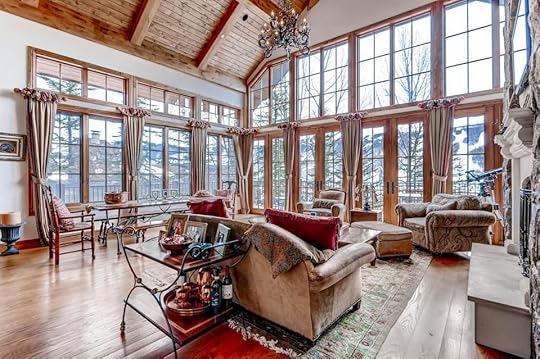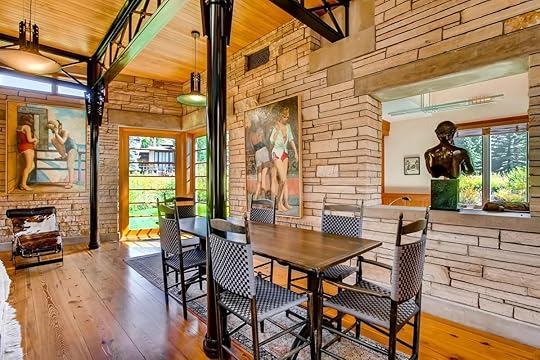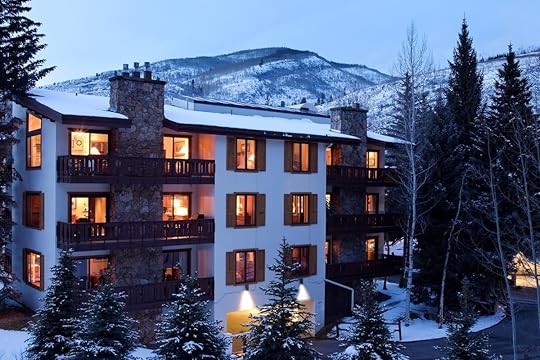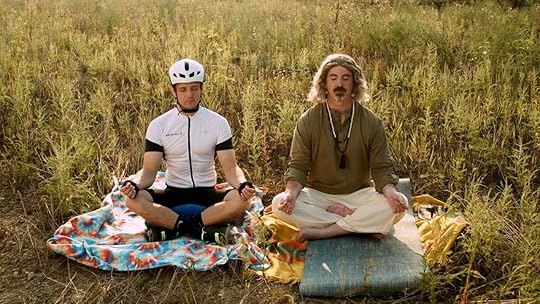Matador Network's Blog, page 560
November 23, 2021
Museum gift shop holiday gifts

If you have not had the chance to visit some of the world’s most admired museums this year , but want to find a unique gift for that special person in your life, check out the online shops of some of the world’s best museums. Museum gift shops cater to every taste, age, and wallet, from fun and tacky key chains to gorgeous art books and games. With the items we selected from world-renowned museum gift shops, you’re sure to create a surprise with thoughtful and unique gifts that will hit the spot for your art- and travel-deprived loved ones.
1. The Museum gift shop of Le Louvre, Paris
Photo: Boutique des musées
The Louvre has a holiday selection in its online gift shop that includes great gift ideas for children and families. Our personal favorite is a pottery kit to reproduce one of the museum’s most-loved pieces: Hippopotamus. On display in the Egyptian Antiquities department of the Louvre, the bright blue figurine is extremely popular with both adults and children, not only because of its adorable look but also thanks to its fascinating story as a funerary statuette found in the tomb of Tutankhamen. The make-your-own blue hippo kit ($22.50) will keep kids entertained and is a great opportunity to teach them tidbits about Ancient Egypt.
For the whole family to share some much-needed fun away from screens, we recommend the museum’s best-seller: Monopoly Louvre ($56). The rules of the monopoly apply, but instead of buying houses and hotels, players purchase art pieces displayed in the Louvre. The pawns are all iconic pieces from the museum, including Venus de Milo and the aforementioned Hippopotamus.
There’s currently a 15 percent discount on all the items if you use the code XMAS21.
2. The Museum gift shop of The Metropolitan Museum of Art (MET), NYC
Photo: The MET Store
For those who want to enjoy a piece of the MET’s collection at home, we recommend buying a 1000-piece puzzle reproduction of the famous “The Unicorn Rests in a Garden” ($24.95) from the Unicorn Tapestries on display at the museum, or the 500-piece “Inside the Museum” ($24.95) puzzle, a fun illustration of some of the treasures to be found at the MET. (The museum’s puzzles are suitable for children of 12 and up, but note that the Unicorn puzzle is a difficult one.) For the Disney-lover in your circle, we suggest the MET’s new beautiful book “Inspiring Walt Disney: The Animation of French Decorative Arts” ($50), which explains how European art made its way into Disney films like Cinderella, Sleeping Beauty, and The Beauty and the Beast.. An exhibition of the same name will be on at the MET from December 10, 2021 to March 6, 2022.
3. The Museum gift shop of The British Museum, London
Photo: British Museum
The British Museum is filled with iconic pieces celebrated throughout the world for their cultural, historical, and artistic values, and the museum’s shop reflects this impressive collection. One of the flagship exhibits in the museum is the Lewis Chessmen, i.e. 82 intricate chess pieces carved into walrus ivory and whale’s teeth in Norway between 1150 and 1200 AD. Discovered in the 19th century on the island of Lewis in Scotland, they have inspired the pieces used in wizards chess in the movie Harry Potter and the Philosopher’s Stone. For fans of mysterious archeological discoveries, Harry Potter, chess, or all three, small ($66) and medium ($315) chess sets featuring replicas of the Lewis chessmen pieces can be purchased. Single replicas ($15) of some of the iconic pieces are also available.
4. The Museum gift shop of the Rijksmuseum, Amsterdam
Photo: Rijksmuseum Shop
If you want to get your children interested in art, check out Amsterdam’s Rijksmuseum’s Playmobil collection. There are Playmobil versions of Van Gogh and Rembrandt painting their self-portraits ($7), as well as great sets representing Vermeer’s “The Milkmaid” ($7) and Rembrandt’s “The Night Watch” ($8), probably the two most famous art pieces in the Rijksmuseum. For adults, the museum’s best-selling items are prints from the Rijksmuseum that have been applied to real canvas to look like the real deal (crackle included) and framed beautifully. The oleographs for sale include “Girl in a white Kimono” by George Hendrik Breitner and “In the month of July” by Paul Gabriël ($90).
5. The Museum gift shop of the Museum of Modern Art (MoMa), NYC
Photo: MoMA Design Store
Being a museum of modern art, MoMa has some of the edgiest gift ideas of all the art museums on this list, from beautifully designed homeware like clocks, teapots, furniture, etc. to trendy decorative pieces and clothing. For a truly original present, check out the Only at MoMa section of the online shop. Our favorite items this year include Mini Lumio+ ($165), a portable book-shaped lamp that illuminates when opened. No bigger than a wallet, Mini Lumio+ has USB ports hidden behind its spine and a lightning port to charge up your phone. Another best-seller at the MoMa gift shop is the beautiful Mama Bird Nesting Doll ($195), a delicate and decorative piece handcrafted by matryoshka masters. Those who have seen Yayoi Kusama’s iconic “Pumpkin” sculpture being sadly swept into the sea in Japan earlier this summer will appreciate the super fun Yayoi Kusama Pumpkin Coin Purse ($120).
6. The Museum gift shop of the Victoria & Albert Museum, London
Photo: V&A Shop
As expected, the world’s leading museum of art and design, the Victoria & Albert Museum, has a lot to offer to art lovers in search of a beautiful gift. The highlight of 2021 at the V&A was the Alice in Wonderland exhibition titled “Alice: Curiouser and Curiouser” and the museum’s gift shop is full of unique items themed around the event. The Cheshire Cat Brooch ($60) created by British brand Tatty Devine is a fun piece of jewellery that is sure to make an impression. For the kids, a modern illustration of Alice in Wonderland ($20) is a great way to read a classic through a new lens. Beyond the exhibition, The V&A also has some of the quirkiest — and designed in London — Christmas decorations out there, like the Queen Victoria coronation ornament ($20).
7. The Museum gift shop of The American Museum of Natural History, NYC
Photo: The American Museum of Natural History Store
The American Museum of Natural History in New York City is the most-visited museum in the United States and this year it celebrated its 150th anniversary. Visit the museum gift shop to support this great American museum and find original presents for your loved ones. Our favorite items this year include the retro-looking Ladies Female Astronaut t-shirt ($25) to inspire all the women in your life to reach for the stars, and the ($16.99), a nod to the iconic 94-foot-long blue whale displayed in the museum’s Hall of Ocean Life. 
A version of this article was previously published on November 23, 2020, and was updated on November 23, 2021, with more information.
More like thisMuseums10 museums that are just as cool on the outside as they are on the inside7 Vail Airbnbs that make you feel like you’re in the heart of Bavaria

Vail is Colorado‘s take on Bavaria. Alpenhaus-style architecture lines the village, and the well-trimmed culture of mountain living is on full display in the pubs, restaurants, and shops. There’s also the legendary ski resort itself, the largest in Colorado and the type of place even a seasoned skier or boarder could spend the entire season exploring and still not have seen it all. Vail is comprised of three villages — Vail Village, Lionshead Village, and East Vail. Here are top options to rent an Airbnb in Vail to capture that Bavarian magic for your next mountain holiday.
We hope you love the top Airbnb in Vail options we recommend! Just so you know, Matador may collect a small commission from the links on this page if you decide to book a stay. Listed prices are accurate as of the time of publication. See our full Advertiser Disclosure here.
1. High-end villa Airbnb in Lionshead Village
Photo: Airbnb

Photo: Airbnb

Photo: Airbnb

Photo: Airbnb
Lionshead Village is a ten-minute stroll (or a quick shuttle ride) west of the central village. Here you’ll find a cozy cluster of homes, condos, restaurants, and pubs that capture the true spirit of alpine living in a luxury setting. Take this villa. High ceilings with bay windows looking out upon the mountains will grab your attention immediately. The kitchen is designed for the chef of your group to prepare gourmet apres-ski meals and cocktails, which you’ll enjoy in the dining area or outside on the massive patio. The home has a private garage for parking and we recommend being the first in your party to arrive (that way you can choose between a village view or mountain view bedroom).
Ten guests, five bedrooms
Price: $2,121 per night

Photo: Airbnb

Photo: Airbnb

Photo: Airbnb

Photo: Airbnb
Solaris is among the most sought-after addresses in Vail. You’ll see why immediately upon entering this perfectly trimmed unit. Onsite are a pool, luxe amenities including concierge, transportation, ski chalet, and a variety of dining. Offsite — just barely — are the ski lifts and the best of the town. Nowhere does Vail like Solaris, and if your family or crew are looking for a high-heeled holiday, look no further than this Airbnb in Vail.
Eight guests, three bedrooms
Price:$1,045 per night

Photo: Airbnb

Photo: Airbnb

Photo: Airbnb
It’s been said that you haven’t stayed in the mountains until you’ve stayed in a chalet. You might as well do it right — and this Potato Patch Chalet is just the place. Massive living rooms give way to a kitchen stocked for a professional chef, and that’s just part of the house. There’s also an indoor jacuzzi, multiple decks, and a steam shower (nothing feels better after a day on the mountain). This Vail Airbnb also features a kids’ room complete with bunk beds, a mini pool table, and plenty of space for toys and games. For the ultimate Vail family holiday, it gets no better than this.
Ten guests, four bedrooms
Price: $1,540 per night

Photo: Airbnb

Photo: Airbnb

Photo: Airbnb

Photo: Airbnb
Gore Creek is Vail’s most defining natural feature, a beautiful stream cutting through the town lined by a beautiful walking path. Master architectural work complements the natural beauty in this high-end home. It’s Insta-worthy but comfortable. If you’re looking to impress your family or group of friends, do it here. This Airbnb in Vail with a pool, hot tub, and fireplace boasts coveted works of art and an open floor plan that begs one to entertain. Be that post-ski drinks or a full-on dinner party, the most common phrase uttered upon entering this property is, “Oh, damn, this place is awesome!”
Eight guests, three bedrooms
Price: $1,000 per night

Photo: Airbnb

Photo: Airbnb

Photo: Airbnb
Riva Ridge is 150 yards from the new Vail gondola, giving you ski-in, ski-out access to a cozy and homey two-bedroom condo in the heart of Vail’s action. When your Airbnb in Vail has vaulted ceilings, a balcony opening onto the snow-covered meadow beyond, and a large living room perfect for lounging around the fire, you know you’ve made the right call. Your steps from the town’s legendary Bavarian restaurants, but the property’s concierge is available to stock your spot with groceries for a night in if you wish. The owner also offers a four-bedroom and a one-bedroom option in case your crew is larger or smaller than the six that can comfortably fit in this unit.
Six guests, two bedrooms
Price: $561 per night

Photo: Airbnb

Photo: Airbnb

Photo: Airbnb

Photo: Airbnb
A ski-in, ski-out Airbnb in Vail is the best way to ensure your family has the easiest ski vacation possible. Here in Lionshead, you’ll be a quick hop to the Lionshead Gondola and when it’s time to come in for lunch, you won’t even have to walk across the village. Toast a grilled cheese and enjoy it on the sofa while watching skiers make their way down the slope. Families love this villa for its kid-friendly bunk bedroom and private adult bedrooms, each with a picturesque view of the town and the mountain.
Eight guests, three bedrooms
Price: $522 per night

Photo: Airbnb

Photo: Airbnb

Photo: Airbnb

Photo: Airbnb
When you think of Bavaria, you probably picture wood-trimmed buildings with warm and cozy interiors. A fireplace, of course, and a balcony overlooking a vibrant place or marketplace below. This alpine apartment is the spitting image of that, cast in brick and mortar in the heart of Vail Village. This unit has it all, with a spacious kitchen and dining area heated by the gas-powered flames of your own private fireplace and opening onto a balcony overlooking the buzzing village below. Get a crew of up to eight together — this place is perfect for three couples or a family — and do the snow dance in style. 
Eight guests, three bedrooms
Price: $759 per night
Where to travel in 2022 if you’re a Sagittarius

When choosing a vacation in 2021, why not pick your destination by zodiac travel? By looking at the elements of your star sign you can line up a trip that perfectly fits your personality. Last month we celebrated Scorpios and now we turn the focus to Sagittarius, the archer of the zodiac, the eternal adventurer and explorer.
As a Sagittarius, you are exuberant, optimistic, and on an endless quest to uncover the truth. You love to delve into the unknown, whether that’s figuratively with your own psyche, the concept of philosophy, religion, and spirituality; or literally with foreign lands and cultures.
You are constantly looking for anything that opens up your horizons. This is reflected by your ruling planet, Jupiter. As the largest planet in the solar system, Jupiterian ideals are noble and high. You will have a strong belief system (and many opinions!), leading you to also be known as the archetype of the teacher. As such, traveling is your forte dear Sag. You’re literally known as the wanderer or traveler of the zodiac! You should feel right at home in this realm and most likely have your own extensive travel bucket list.
You’re part of the fire element triplicity (along with Aries and Leo, who would also make good travel buddies for you), which means you are bold and fiery. You have energy to burn and a general zest for life. You enjoy being active and prefer excitement over the mundane. Doing things that are new and unusual, where every day is different and you are allowed to roam free, will suit you better than a leisure or organized group vacation.
You’re also what’s known as a mutable sign (along with Gemini, Virgo, and Pisces), the ones that come at the end of seasons. This makes you flexible and adaptable, eager to get things finished and move on to the next thing (although staying power may come less naturally to you). This means that you will need lots of variety on your zodiac travel trips! No two days should be alike, sticking to a rigid schedule is just not for you.
With all that in mind, let’s see where are the best zodiac travel ideas if you are a Sagittarius.
1. Gobi Desert, Mongolia2. Smoky Mountains National Park, US3. Reykjavik, Iceland4. Cappadocia, Turkey5. Avenue of Baobabs, Madagascar6. Torres del Paine, Chile7. Moab, US1. Gobi Desert, Mongolia
Photo: Galyna Andrushko/Shutterstock
Now if you want epic adventures and authentic, wild experiences, Mongolia is the place to visit! With its relatively untapped tourist market, you can experience true-to-nature cultural journeys that will immerse you in local traditions. Because of this, it’s also necessary to plan well in advance and easiest to take an organized tour through the desert — I know this is a turn-off for you Sag but I promise it’s worth it! The sights you’ll see will be so damn cool you’ll forget all about the planning you had to do beforehand to get to them.
2. Smoky Mountains National Park, US
Photo: Dean Fikar/Shutterstock
This Tennessee national park is an awesome option for your zodiac travel due to the sheer amount of adventures you can have here. There’s a wide variety of landscapes and activities to choose from; ranging from whitewater rafting to canyoneering, to deep cave diving, bouldering, camping, and more! Let your wild heart take you where it pleases and allow your vast imagination to roam free. Four full days are recommended here to be able to fit in all the sights, plus have ample time to explore Gatlinburg or Pigeon Forge if you wish.
3. Reykjavik, Iceland
Photo: kovop58/Shutterstock
Iceland is another travel destination that has everything you could wish for — broad Martian-like landscapes, otherworldly experiences such as the Northern Lights, varying extreme weather conditions which are an adventure in and of themselves, an active volcano, and the mythic Blue Lagoon. Iceland is a popular choice for adventurers because you can easily go off track and get lost in the awesome nature, but if you ever get too lost the locals are known for their friendliness! And for someone who loves to converse as much as you do, half the fun of traveling is the amazing people you meet.
4. Cappadocia, Turkey
Photo: Alla Laurent/Shutterstock
This is an excellent spot for you Sag because it has all the appeal of rich historical city life, but also incredible nature and adventures to be had nearby. There are Bronze Age homes carved into valley walls by troglodytes (cave dwellers) that were later used as refuges by early Christians; a 100m-deep Canyon housing numerous rock-face churches in Ihlara; and “fairy chimney” rock formations in Monks Valley. You can go dune buggying, snake your way through one of their Byzantine underground cities, and, of course, take one of those famous idyllic hot air balloon rides!
5. Avenue of Baobabs, Madagascar
Photo: Michail_Vorobyev/Shutterstock
This beautiful country is sure to capture your imagination with its tropical nature and huge amount of biodiversity (one of the highest in the world and 96% endemic)! Plus, Madagascans are known for their positivity, ensuring you’ll feel right at home with the people you meet here. You can come face-to-face with towering baobab trees, see super unique rock formations at Tsingy de Bemaraha Strict Nature Reserve, snorkel with sea turtles at The Three Bays, as well as wind or kite-surf. Then, take your pick from Lokobe, Mantadia, or Isalo National Park to meet the Madagascan national animal, the lemur!
6. Torres del Paine, Chile
Photo: kavram/Shutterstock
Patagonia is a must on any true adventurers travel list, and for good reason! Home to some of the world’s most awe-inspiring landscapes, Torres del Paine will blow you away with its magnificence. Featuring towering glaciers, soaring mountains, and bright blue icebergs, this immense national park is a once-in-a-lifetime experience. Travel tips for this monumental journey include: going between November-March; packing highly functional, warm clothing; and doing the eight-day trek on the O Circuit to see the iconic skyline of the mountain formations that gave this site its name (the “blue towers”).
7. Moab, US
Photo: dibrova/Shutterstock
The massive red rock formations and landscape in Arches National Park are truly a sight to behold. You’ll love trekking around here because it has mesas and buttes, Native American rock art, and dinosaur tracks at Bull Canyon Overlook and Canyon Ridge! You can let loose four-wheeling on the thousands of miles of off-road territory, go whitewater rafting, and do all the hiking you could desire. The town itself also has local charm and is worth spending some time in when you’re not too busy exploring the surrounding area.
In summary, anywhere that has raw terrain and unfiltered connections to be had with nature, wildlife, and people is right up your street Sagittarius. As long as you can combine activity, action, and adventure, with variety, diversity, and mind-broadening experiences, your internal zodiac travel flames will be stoked even more! 
November 22, 2021
Watch: Serial 1’s new e-bike etiquette video is a hilarious lesson in sharing the road

ANYONE WHO OWNS a bicycle — e-bike or otherwise — knows there’s a growing rift between e-bikers and human-powered bikers, especially when it comes to etiquette on trails and roads. But it’s understandable — after all, when you buy a new e-bike, it’s easy to get so excited that you end up buying a full cycling kit, right down to the personalized cycling jersey. And since your e-bike will be much faster than your old road bike, you’ll need to time your rides on a cycling app like Strava. Those personal records matter, and the last thing you want is for a recreational cyclist to get in the way when you’re aiming for a 6 AM speed record.
Except, no.
Enter the newest tongue-in-cheek video from Serial 1 Electric Bikes. Thankfully for the family of an obsessed e-biker, the Serial 1 “E-bike Guru” is on hand to help said cyclist enjoy the ride, offering helpful suggestions about how to relax and co-exist with fellow cyclists (and to stop trying to run the local mail delivery tween off the road).
Serial1 is owned by Harley Davidson and entered the e-bike market in November 2020. That makes them a relative newcomer to the electric bike market, currently a $16.9 billion industry (and expected to reach upward of $50 billion in the next 15 years). E-bikes were the fastest-growing cycling segment with the overall bike industry over the last 18 months.
With an estimated 500,000 e-bikes expected to be sold in 2021, it’s no wonder brands like Serial 1 are encouraging new buyers to practice good cycling etiquette (and to not scream at neighborhood children).
Remember, as the e-bike guru says, “You don’t need a watch to enjoy the ride.” 
‘The Great British Baking Show: Holidays’ promises a joyful celebration of festive treats

Beloved British baking competition, The Great British Baking Show, is set to return with the fourth season of its holiday-themed special, The Great British Baking Show: Holidays. This festive extravaganza features “ghosts of bakers past,” as host Matt Lucas quips, including Rahul Mandal, Ruby Bhogal, and Helena Garcia for New Year’s special. Tom Allen, comedian and a frequent guest on the Baking Show’s after-show The Great British Bake Off: An Extra Slice, will host another special in the series, which according to a vague press release from Netflix, might feature the cast of Derry Girls.
The trailer for the holiday series promises much of the same cheerful attitude that the show is known for. Yes, it looks like it still gets tense under the tent, but the competitors are full of good cheer, banter, and jokes to keep the mood light. That doesn’t mean the competition isn’t challenging: The trailer reveals that one showstopper challenge involves creating an “illusion cake,” made to resemble a holiday feast.
The trailer doesn’t reveal much more about what the bakers might be whipping up this season, but in the spirit of the show, it still looks like the competitors are still good friends, which makes all their inevitable baking-related tribulations a little bit easier to watch. As for what bakes the judges have in mind, perhaps they might include a few of these classic English desserts.
The cast of Derry Girls unfortunately isn’t revealed in the trailer, but it does make sense that perhaps Netflix is keeping their appearance under wraps as a fun Christmas present to viewers.
What we do know for sure is that the holiday season is just more jolly with Noel, Prue, Matt, and Paul on our television screens providing some needed comfort (and perhaps even baking inspiration when it comes time to create our own Christmas feasts) to these chilly winter months.
The Great British Baking Show: Holidays season 4 premieres on December 3 on Netflix. 
YouTuber Footless Jo shows what it’s really like to fly with a prosthetic leg

Flying as an able-bodied person has the potential to be uncomfortable, but to fly with a prosthetic leg is a completely different ball game. For those who are unfamiliar, or even take for granted how easy it is to travel as an able-bodied person, YouTuber Footless Jo shows us what it’s like to travel by plane as an amputee.
Jo Beckwith, AKA Footless Jo, severely injured her ankle almost two decades ago in a horseback-ridding accident. Following complications from that accident, she had her leg amputated below the knee in October 2018.
Jo now wears a prosthetic leg that has a seal-on suction system with a tight-fitting, rubber-like sleeve and liner that allows the artificial limb to stay on properly, but the pressure it creates can be very uncomfortable especially when she sits for a long time. While Jo can relieve some of that pressure thanks to a valve in her leg, the air pressure changes that occur during a flight make it very unpleasant for her. That’s why she needs to take the time to remove her leg after and in-between flights, as well as massage and elevate her limb remnant.
Jo flies with her prosthetic leg attached. TSA allows prosthetics in carry-on and checked luggage, but for amputees that can obviously translate to a lack of mobility and independence, and traveling in a wheelchair can be very challenging.
Unsurprisingly, Jo has to carry all sorts of special tools and accessories with her when she travels, including an extra liner, extra sleeves, some special padded socks for comfort, a special tool to remove the foot from her prosthetic leg, lubricant, special detergent for her sleeves and liners, her running blade and a hex key to fit it onto her leg.
To learn more about Jo and what it’s like to live and travel with a prosthetic leg, check out her YouTube channel Footless Jo, her TikTok, and her Instagram account. 
Looking for a coworking space on your next trip? Try the nearest mall.

American malls need a fresh take to compete with online shopping. A 2020 report from Coresight Research estimates that 25 percent of the 1,000 malls in the US will close over the next three to five years, and the pandemic is accelerating this process. That begs the question of what to do with this prime real estate that used to serve as a centerpiece of America’s communities. Some suggestions have included warehouses, churches, medical facilities, apartment complexes, and office space. But it could be a trend made increasingly popular by the pandemic that helps bring people back into malls — remote work.

Photo: SaksWorksFacebook
The pandemic has companies from tech startups to established corporate powerhouses reconsidering the need for vast amounts of office space. But not everyone wants to work from home, without the social interactions and opportunities for networking (and of course, griping about work) that an office provides. Enter the coworking space. Offering office or desk space for lease to remote workers is a growing trend. Statista Research Department reports there are currently over 23,000 co-working spaces in the US, with that number expected to rise to over 41,000 by 2025. As retailers close storefront space in malls, coworking spaces are stepping into certain vacancies to fill the void.
Saks Fifth Avenue and WeWork created a joint-venture called SaksWorks, offering stylish workspace combined social clubs in different Saks locations. In December, five New York-based SaksWorks locations will open, with the trend expected to extend to Boston, Los Angeles, Philadelphia, and Seattle. As of 2018, 21.3 percent of coworking spaces were located in department stores and similar such large commercial operations, and are found all over the world. You’ll find Cre8 Community & Workspace at PIK Avenue Mall in Jakarta, Indonesia; Bespoke Co-working at Westfield Mall in San Francisco; and Mindshare Workspace at Erin Mill Town Centre in Mississauga, Toronto, Canada.
So the next time you’re on the road and need a quiet space for a Zoom call or desk to hunker down at to push through your to-do list, check in with the local mall. It may just be the perfect workspace you never knew you needed. And, the coffee is on the house. 
This winter capsule wardrobe will keep you warm and city-sleek

With snow-covered buildings and festively decorated streets, wintertime in the city can be a wonderland. That said, if you’re anything like us, you might be trudging past skyscrapers or to the theater dressed like a marshmallow in the cold — sporting layers on puffy layers on more layers. Although we cannot deny the beauty of a snow-adorned city, you may not necessarily want to go holiday shopping so much winter clothing that you can not lift your arms. That is why Matador Network has compiled our winter capsule wardrobe of classic outfits that will keep you warm and looking city-slick this winter.
We hope you love the winter clothing we recommend! Just so you know, Matador may collect a small commission from the links on this page if you decide to purchase. Listed prices are accurate as of the time of publication. See our full Advertiser Disclosure here.
1. Fjällräven Nuuk Parka
Photo: REI
Your jacket can make or break a cold day, and if you aren’t into the puffy jacket scene, the Fjällräven Nuuk Parka is for you. With a durable water repellent finish, cuff closures, and interior drawcords at the waist to seal out cold, this coat is a game-changer when it comes to warmth. Two fleece-lined handwarmer pockets keep your fingers toasty and interior pockets help keep your valuables safe. A cozy jacket that looks good and feels good, the Nuuk Parka is the perfect fit for any winter day out in the city.
Price: From $500.00
2. Cotopaxi Coso 2L Hip Pack
Photo: REI
The Cotopaxi 2L Hip Pack is ideal for the city or mountains. Made from 100% recycled nylon, the no-hands convenience of this hip-pack makes it more than easy to access your essentials — whether it’s your phone or gloves. Wear it around your hip or torso, this pack looks great no matter where you are.
Price: $55.00
3. Baffin Northern Boot
Photo: Baffin
Don’t forget about your toes when dressing for the city in winter. Snow-lined sidewalks and blistering winds don’t just affect your upper body — they can leave your feet cold and wet. And cold and wet feet can ruin your entire day. That’s why we’re in love with the Baffin Northern Boot. A stylish booth built for comfort, the Northern Boot is crafted from waterproof and slip-resistant materials that are perfect for wet and cold city streets.
Price: $210.00
4. Royal Robbins Ventour Sweater
Photo: Royal Robbins
We all love a big cozy sweater, but the truth is, they aren’t necessarily the best when layering for a blistering cold day in the city. The Royal Robbin’s Ventour Sweater is a versatile merino blend sweater that provides both warmth and helps regulate temperature. Open stitching in high heat areas means you’ll stay warm without overheating, and help prevent that dreaded feeling of a cold wind on sweat.
Price: From $85.00
5. Nite Ize RunOff 3-1-1 Waterproof Pouch
Photo: REI
If you don’t get wet during a winter storm, you are one of the lucky ones. If your phone doesn’t get wet, you’re even luckier. That’s why we’re recommending the Nite Ize Waterproof Pouch. The waterproof material keeps your valuables dry when that unexpected snowstorm hits, the translucent front makes digging for keys a thing of the past, and integrated anchor points allow for easy attachment. Do yourself, and your phone, a favor — make a waterproof pouch an essential for winter exploration.
Price: $35.00
6. Forsake Lucie Mid Waterproof Shoes
Photo: REI
Stylish, waterproof, breathable — the Forsake Lucie Mid is the classic city winter boot we all want. The premium full-grain leather and memory foam footbed keep this boot stylish and comfortable. The anti-odor mesh lining means you can wear this on the trails and then into your favorite restaurant in the city. Short and simple — this is a durable boot that was designed to go anywhere.
Price: $139.95
7. Orvis Quilted Snap Sweatshirt
Photo: Orvis
We’re in love with the Outdoor Quilted Snap Sweatshirt. Why? Because not only does the pure quilted cotton feel extra comfy when walking between skyscrapers, but the polyester fill and snap-up neckline keeps cold out and the warmth in. Thin enough to layer under a jacket and vent, and warm enough to keep the city winter at bay, the Orvis Quilted Snap Sweatshirt is one of our favorites for exploring any urban center during the holidays.
Price: From $98.00
8. Duer No Sweat Pant
Photo: REI
If you’re not a jean fan, then you might fall for the Duer No Sweat Pants. While they look like a pant, Duer’s signature blended fabric feels soft like your favorite pair of sweats. Great for all activities — these will keep you warm between shops in the city and provide enough stretch to keep you comfortable when hitting the trails (or pub after holiday shopping).
Price: $129.00
9. Klean Kanteen Insulated Classic 20oz With Loop Cap
Photo: Klean Kanteen
Warmth doesn’t just come from the outside, it can come from the inside too! That’s why we’re including the Klean Kanteen Insulated Classic 20oz bottle. There’s nothing better than sipping on hot coffee or tea when you’re exploring a city decorated with holiday lights and ornaments, and this Klean Kanteen bottle keeps drinks hot for 24 hours. This sleek design moves away from larger, clunkier bottles, and is sure to fit in with your winter city adventures. They also sell these adorable Kid Classic Water Bottles.
Price: $26.95
10. Indyeva Borallo Puffy Jacket
Photo: Indyeva
Who doesn’t love a long and cozy puffy jacket? The Indyeva Borallo provides 600FP, RDS certified down and laminated fabric for extra protection from any snow that might come your way. A minimalist design with a microfleece lining and side openings with snaps makes this jacket perfect for city winters without giving you the marshmallow effect. Sleek, stylish, and extra warm, this down blend coat is perfect for holiday shopping, hot cocoa drinking, and everything in-between.
Price: $350.00
11. Patagonia Capilene Air Base Layer Bottoms
Photo: REI
Pants on pants may not be your first thought, but hear us out. Even when wet, the Patagonia Capilene Air Bottoms continue to insulate. Even better, they dry quickly and resist odors. Slide them on under a pair of pants to keep you extra warm — and no one will ever know. Soft and light, the merino wool blended with recycled polyester gives warm, moisture-wicking durability that will keep you cozy in any temperature.
Price: $129.00
12. Fjällräven Kånken Pack
Photo: REI
The Fjällräven Kånken Pack is our go-to for city exploration. The water repellent finish deflects light rain and snow, and the classic, minimalist style means it fits right in with any city’s vibe. The spacious main compartment is perfect for extra layers, and two side pockets can fit slim water bottles to keep you hydrated. One of our favorite parts — it comes with a removable seat pad, so even when there’s snow on a city park bench, you’ll always have a place to sit.
Price: $80.00
13. Costa Del Mar Polarized Sunglasses
Photo: REI
Have you ever heard of snow blindness? The reflection of the sun on snow can be so bright that long exposure can essentially sunburn your eyes — leaking pain and discomfort. Though these won’t do too much for warmth, the Costa Del Mar Polarized Sunglasses are scratch-resistant and polarized which decreases eye strain. They offer 100% protection from UV light, meaning that the beautiful snow streets you explore won’t hurt your eyes, and you’ll be able to enjoy every Christmas shop and market you come across. 
Price: $249.00
More like thisFashionThis sweat-absorbing shirt is my favorite thing to wear when I flyNovember 19, 2021
All your 2022 travel questions answered, from vaccinations to testing to flight cancellations

The world is slowly starting to open up again, and many travelers are itching to hit the skies after almost two years of lockdown. However, the world has changed, and travel can be extremely confusing with COVID-19 testing procedures and requirements. Depending on where you’re going, what the regulations are, and what airlines require of you, there are dozens of things to add to your “must-do” list for travel. We’ve decided to compile the top 5 questions we’ve been asked about travel so you can get on that plane without missing a step.
Do I need a PCR test or vaccination for my trip?In short, probably. The longer answer — it depends. PCR tests became the norm for many countries as they reopened, even in 2020. As vaccinations started rolling out across the world, many countries have added the vaccine as a requirement for entry, either in place of a PCR or antigen test, or along with a PCR or antigen test. Anywhere from Anguilla to Zambia, requirements call for some combination of testing and vaccination.

Photo: View Apart/Shutterstock
To make matters more complicated, even if the country you are traveling to does not require either today, it does not mean they won’t change their rules by the time you travel. It’s absolutely imperative that you stay up to date on the regulations before and during your trip. There are also a few things to keep in mind when it comes to testing and vaccination:
What airline are you flying? Some airlines, regardless of what a country requires, are at a minimum requesting a PCR test to board the plane. Be sure to check your airline’s COVID-19 FAQs to ensure you meet their requirements. I recently checked into a flight where a traveler next to me was denied his boarding pass because he did not have a PCR test. He insisted his destination did not require it, but he failed to check the airline’s regulations, which unfortunately meant he was unable to fly.Do you have a layover? Some countries may require testing or vaccinations to even transit through their airport. Be sure to check the government websites for both your transit country and destination to verify all requirements, as it’s possible that even if your destination does not require a test or vaccine, your transit airport might.What is your final destination? Depending on the country, you may be required to have a test and/or vaccine. CNN offers a pretty comprehensive, updated list that you can take a look at, here. Keep in mind, as well, that depending on the country, you may have to meet certain requirements to access certain areas of the country or certain types of activities or facilities. For example, during a recent trip to the Maldives, I was not required to be vaccinated if I was staying at a private island hotel. However, if I were to have booked a stay on a local island, it would have been required.If your travel requires a test, be sure you know the time restraints on it. Like much of the Caribbean, Maldives, and others, many countries require a PCR or antigen test within 72 hours of travel. Some countries may require a test within 24 or 48 hours of travel. This time limit is often down to the hour, so be sure you meet those time regulations beforehand. And no, the airline will not accept any excuses. You can try and chance it, like someone I met at the airport recently who got a test 7 days out, but just like him, you may end up screwed and miss your flight.Does your destination require a specific type of vaccine? Most countries acknowledge the major vaccines like Johnson & Johnson, Moderna and Pfizer. If you got vaccinated with some of the other globally available vaccines, be sure to check the government websites to make sure they accept them. This is particularly important if you are taking a cruise. Many cruise companies are being extremely strict with the types of vaccines as well as how long ago you received them.Vaccine or PCR test aside, it’s also important to check if you need to complete any paperwork prior to your departure. Many countries are requiring “passenger locator forms” to be completed before you leave your home country and travelers receive a QR code that’s necessary to enter their destination. For example, Greece requires this at least 24 hours before your departure from home.
One important note about the locator forms — make sure you are accessing the actual government forms and not a scam website. There are a number of websites claiming to be the passenger locator form but often require you to pay. For example, when you search “Greece passenger locator form” on Google, you will see:

Photo: Google
Notice that the first two links are actually NOT on the government website, denoted by their URL. The third link is the true government site: travel.gov.gr. This is also the only site that will not charge you to complete the form. If you are uncertain, be sure to call your airline to get the correct link.
Do I have to wear a mask to travel?In most cases around the world, you are still required to wear a mask the moment you step into the airport, all the way through to your destination. While you may have heard that several Scandinavian countries no longer require masks within inter-region flights, this is a rare case. In the US and across the world, airlines continue to require face masks, and in most cases, medical-grade face masks onboard.
Do also keep in mind that the country you are traveling to may also have COVID-19 restrictions and requirements in place. For example, the Dominican Republic requires face masks in all public areas, including grocery stores and shops, but those rules do not apply to resort properties. While your hotels and tourist locations may not require them on property, be aware of the laws if you plan to venture into town or local areas.
If I leave the US, are there any requirements to get back in?If you plan to take a trip abroad, you must be sure you can meet the requirements to get back in. Since January 26, 2021, any traveler planning to return to the US must hold a PCR test, viral antigen test, or proof of recovery, regardless of vaccination status. If you are unvaccinated, you must complete the test within one day of your flight. If you are vaccinated, it must be completed within three days of your flight. Viral antigen tests are typically less expensive than PCR tests and have a much quicker turnaround time for results. However, since PCR testing is the standard worldwide, it may be easier to find PCR testing in some clinics.
When planning your trip, it’s important to remember that you will need to get a verified test to come back home. Many destinations worldwide, like the Maldives, Mexico, and the Dominican Republic, offer government subsidized testing onsite at their hotels. The Dominican Republic, for example, even provides complimentary antigen testing for all guests of the hotel. If you are planning to stay in an Airbnb or apartment, be sure to ask the host about clinics in the area that can accommodate you, or check with your departure airport to see if they offer rapid testing.
While many at-home testing kits have become available, it’s important to remember that not all of these tests are approved for re-entry into the US. In fact, only a couple at-home testing kits available at your local pharmacy will suffice, and it’s required that they include a telemedicine portion, like Abbott’s BinaxNOW. But at $150, it’s not cheap, and many countries offer viral antigen testing for around $20-40. However, if you’re looking for peace of mind and not exploring the local clinics, this could be a good option.
What happens if my flights get cancelled?Every week, there are dozens of articles and news clips detailing the hundreds of thousands of delayed and cancelled flights. Whether they’re claiming the elusive “air traffic control” or the shortage of flight attendants and pilots following the vaccination requirements, it’s disruptive and frustrating for travelers. It’s critical to make sure you have a Plan B and sometimes even a Plan C.
First things first: make sure you book that flight on the right credit card. American Express Platinum and Chase Sapphire Reserve & Preferred offer excellent travel protections in the event that things go wrong. Whether you need a hotel room for a night while you await your rebooked flight or amenities and toiletries when your luggage inevitably gets lost, they have you covered. Booking on the right card can be the difference between sleeping on that airport floor or resting easy in a decent airport hotel room.
Second of all, the moment that flight is canceled get in line at the airport counter and get on the phone in case customer service picks up first. One pro tip here: if you are flying American Airlines, United or Delta and have lounge access (like you would if you booked your Delta flight on the AmEx platinum), go straight to the counter at the lounge. They are much faster and can get you rebooked ASAP. This happened to me recently on a flight to Paris. We were sitting in the lounge when we saw the cancellation and the Delta customer service counter helped us immediately. Within five minutes, we were rebooked on an Air France flight that actually arrived earlier than our original flight.
Lastly, be sure to get to the bottom of who’s “fault” it is and what you’re entitled to. If the airline cancels on you, they have a few “outs,” namely weather and air traffic control issues. However, if it’s due to staffing or other issues, you are required to be rebooked and accommodated at no expense to you. Gather all receipts, proof of cancellations or delays and be sure to call your credit card company to open a claim immediately.
Is now the time to book non-refundable travel?If there is only one thing you take away from this entire article, let it be that now is absolutely 100% NOT the right time to go non-refundable, particularly if you are a few months away from your trip. Whether you’re booking holiday travel or your spring break trip to Cabo, going non-refundable is just asking to lose money. There are some fantastic deals out there right now to travel into 2022, and you should absolutely take advantage of them. However, be sure that they offer changes or cancellations.
Given the current travel climate, many companies are very flexible with free changes and cancellations, so there really is no reason to go with the most strict booking terms just to save a few bucks. While the deal might seem amazing, it’s simply not worth the risk in case the country shuts down, your flights get canceled, you fall ill, or the trip just doesn’t happen.
Many hotel loyalty brands offer elite status holders, or even basic members, free cancellations or changes on their discounted rates. So be sure to join loyalty programs as you book hotels to get the best rates with the best booking rules.
ConclusionIf you’re still reading this, congratulations, you’ve made it to the end. To sum things up, travel is hard right now. It’s confusing, stressful, and can honestly be exhausting. However, knowing the rules, being prepared and having a Plan B(C, D, etc.) can make things so much easier. Remember to document everything, print copies of your tests and vaccines and be sure to book those flexible rates whenever possible. From one traveler to another, take a deep breath, don’t worry, you got this. 
Beautiful travel coffee-table books

Nothing beats exploring new places, but sometimes, armchair travel gives us access to parts of the world we might not otherwise have the privilege of experiencing. Artfully curated photography collections have the ability to do just that. The following art-meets-travel books take readers all over the globe from the comforts of their homes, whether it’s a series of images shot in the most remote destinations on Earth, an insider’s guide to Chernobyl, or a visual love letter to air travel itself. Across continents, cultures, and aesthetics, these are nine coffee-table books every traveler should have.
We hope you love the books we recommend! Just so you know, Matador may collect a small commission from the links on this page if you decide to purchase a book. Listed prices are accurate as of the time of publication. See our full Advertiser Disclosure here.
1. Mother: A Tribute to Mother Earth
Photo: teNeues
At 320 pages, Marsel van Oosten’s Mother: A Tribute to Mother Earth is one of the most ambitious and exquisite photography collections of the year. Featuring 170 large-format images taken on five different continents over 15 years, the book not only pays homage to the world’s extraordinary biodiversity but also to Oosten’s award-winning career as a wildlife and nature photographer.
There’s more to this book than pretty pictures, however. Oosten compiled the collection with conservation in mind, aiming to raise awareness about ecological issues and encourage readers to respect and protect the planet. His images are paired with insightful commentary, as well as an in-depth interview with environmental activist Aleena von Storms. Evolutionary biologist Bret Weinstein penned the foreword.
You can purchase Mother: A Tribute to Mother Earth on Amazon. One hundred copies of a collector’s editions are also available, featuring 72 extra pages, 58 extra photographs, a handful of three-foot-wide double fold-outs, and more. A portion of the proceeds will be donated to The Canopy Project, which pledges to plant five trees for every book sold and 50 trees for every collector’s edition.
2. Seeing Silence: The Beauty of the World’s Most Quiet Places
Photo: Rizzoli
Photographer and filmmaker Pete McBride traveled to the most remote corners of the globe, where the only ambient noise is the sound of nature, to capture the images in this book. Published in September 2020, his collection takes readers to places many people only dream of visiting, from Mount Everest and the Nile to the Amazon Rainforest, Atacama Desert, and Antarctic Peninsula. Each image captures the elements of the natural world that create the soundtrack to these destinations, notably the native fauna.
In addition to McBride’s crisp, vast, and striking photographs, Seeing Silence: The Beauty of the World’s Most Quiet Places includes an essay by Erik Weihenmayer, the first blind climber to summit Everest, and a foreword from environmentalist Bill McKibben. The book is available for purchase on Amazon.
3. Accidentally Wes Anderson, The Book
Photo: Accidentally Wes Anderson
The Accidentally Wes Anderson Instagram account (AWA) could be the dictionary illustration for the term “Instagrammable” — the photos featured are vibrant, a little retro, and perfectly framed. But they do more than quickly please the eye during a frenetic scroll; they also allow followers to travel through time, cultures, and countries.
The incredible success of the Instagram account since its start in 2017 led its founders, husband and wife Wally and Amanda Koval, to take their followers’ talent one step further — from people’s phone screens to their sitting rooms. In October 2020, AWA released Accidentally Wes Anderson, The Book, a coffee-table book compiling 200 photographs from as many locations submitted by followers. And flicking through this book, all you’ll want is to see those places and buildings for yourself. The cover alone, a photograph of the Belvédère Hotel in Switzerland, is enough to make you want to pack your bags.
Although AWA is not run by Wes Anderson or by anyone on his team, the account and Accidentally Wes Anderson, The Book honor the movie director’s aesthetic to perfection. It highlights some of the best of global architecture, art, and design with a bright color palette, symmetry, and certain quirkiness. The foreword of the book has been written by Wes Anderson himself, who is said to have been thrilled by the project. You can purchase Accidentally Wes Anderson, The Book from Amazon.
4. Chernobyl: A Stalker’s Guide
Photo: FUEL Publishing
After visiting Chernobyl 20 times on multiple-day trips, including once covertly with a “stalker” as those who visit the area illegally are known, Darmon Richter wanted to share his love and fascination for the infamous Ukrainian city in a photo guide-cum-travelogue: Chernobyl: A Stalker’s Guide, published in September 2020.
Richter, a writer and photographer, is deeply interested in the past and present of the evacuation zone and its people, and he wanted others to learn more about Chernobyl than the usual cliché spread by the often-sensational tours of the exclusion zone. He was keen to show that there’s much more to the 1,000 square miles of the zone than devastation and sorrow, strategically placed gas masks, and rusty Ferris wheels, so he included over 100 photographs of the unexpected beauty of the site, including its wildlife, murals, buildings, stained glass, forests, and more.
Although Richter does not encourage readers to do as he did and take an illegal tour of the exclusion zone, his experience will make them want to see the site for themselves and understand it beyond the 1986 nuclear disaster to know its extraordinary past and its hopeful future. Chernobyl: A Stalker’s Guide is available on Amazon.
5. Drivebys
Photo: Brian Bowen Smith
At the very start of the COVID-19 pandemic when the US was almost entirely shut down, professional photographer Brian Bowen Smith and one of his assistants hit the road. In a quickly made decision, they drove a 1958 Ford F100 and a 1993 Winnebago 11,000 miles around the country to document life during this exceptional time in US history.
Shooting in black and white, Smith got his cues from Instagram followers excited about the project. For a month, with his Leica M10 Monochrom in hand, he went where people with good ideas for a picture dictated him to go. Among many others, he captured horse-riding cowboys and happy families, empty Times Square and a masked Elvis impersonator in a deserted Las Vegas, struggling dairy farmers and hospital staff — all from the large window of his old-fashioned truck. He then compiled them in Drivebys.
Like a visual memoir of life in the spring of 2020, Drivebys has the potential to become an iconic American book, one that in a few years will take readers back to a strange and almost surreal period of time.
After seeing the difficulties experienced by the people throughout the US, Smith decided to give the proceeds from the sale of the book to Feeding America.
Buy Drivebys now from Brian Bowen Smith’s website. Both paperback ($40) and leatherbound editions ($500) are available.
6. Airline Visual Identity 1945-1975
Left: Stan Galli. Right: David Klein. Courtesy of Airline Visual Identity 1945-1975.
If you miss the golden age of plane travel when the seats were large and plushy, the food was free and plentiful, and the airline ads looked like they belonged in art galleries, then you need to get yourself a copy of Airline Visual Identity 1945-1975.
Although originally published in 2014, a new and limited collector’s edition of Airline Visual Identity 1945-1975 was released in the fall of 2020 and is filled with some of the industry’s most gorgeous airline posters that have ever existed. Because before television advertisements, low-cost airlines, and the deregulation of the airline industry in the US, all each airline could do to differentiate themselves and attract potential travelers was create beautiful, enticing posters that would make them choose TWA over Air France. Through vibrant colors and humorous, cheery, and glamorous modern illustrations hung in airports and travel agent offices, they caught people’s eyes and made them dream of faraway places.
Airline Visual Identity 1945-1975 is comprised of hundreds of high-quality poster reprints that are sure to transport you to a time when air travel was luxurious and almost beautiful.
7. America the Beautiful: A Story in Photographs
Photo: Disney
Released in October 2020, at a time when America was, and remains, extremely divided, National Geographic’s America the Beautiful: A Story in Photographs is a book that works as a unifying force.
Photographs from 130 years of National Geographic archives honors the undeniable beauty of the nation, from the Alaska wilderness to the California coast, and includes words from celebrities, conservationists, politicians, and more prominent figures, across all 50 states, six territories, and Washington, DC, expressing their love for their country.
The 384-page hardcover book is a reminder that even at one of the most uncertain times in US history there’s one thing all Americans can agree on and celebrate together: their country’s spectacular nature and dazzling majesty.
America the Beautiful: A Story in Photographs is available for purchase on Amazon.
8. Born to Ice
Photo: Paul Nicklen
Famous National Geographic photographer Paul Nicklen released his gorgeous Born to Ice coffee table book in 2018, but there’s never been a better time to fully appreciate the world’s polar regions and their inhabitants, whether they be humans or animals.
Because Paul Nicklen is not all just a talented photographer and storyteller, he’s also a naturalist, as well as a passionate conservationist and climate activist. While showcasing the beauty and fragility of the wilderness of the Arctic and the Antarctic, he successfully triggers inside all of his readers the need for taking action against climate change, the ardent motivation to do our part to protect the planet and all its inhabitants, and the intense desire to see, with our own eyes, the beauty of the poles while they are still there to be admired. Buy Born to Ice from Amazon.
9. At Glacier’s End
Photo: Chris Burkard
Iceland has been a hot tourist destination, welcoming every year several times more international visitors than its entire population. And its popularity is due, first and foremost, to its grandiose landscapes — green hills, volcanoes, waterfalls, rugged coastlines, geysers, etc.
After taking many trips to the island nation, surf and adventure photographer Chris Burkard and writer Matt McDonald have learned to revere Iceland’s natural assets, particularly its threatened glacial rivers, which originate from the country’s highlands, an area often overlooked by visitors.
In At Glacier’s End, a gorgeous coffee-table book composed of Burkard’s aerial photos and McDonald’s words, they highlight the beauty of the Icelandic Highlands from where glacial rivers originate and advocate for the rivers’ plight as they remain unprotected and often damned.
By combining their talents, they are hoping to encourage tourists to Iceland to stray off the well-worn paths to visit the region and contribute to the conservation movement that would protect it and eventually lead to the area becoming Highlands National Park. 
A version of this article was previously published on November 18, 2020, and was updated on November 19, 2021, with more information.
More like thisBooksThe most popular book set in every country in the worldMatador Network's Blog
- Matador Network's profile
- 6 followers



